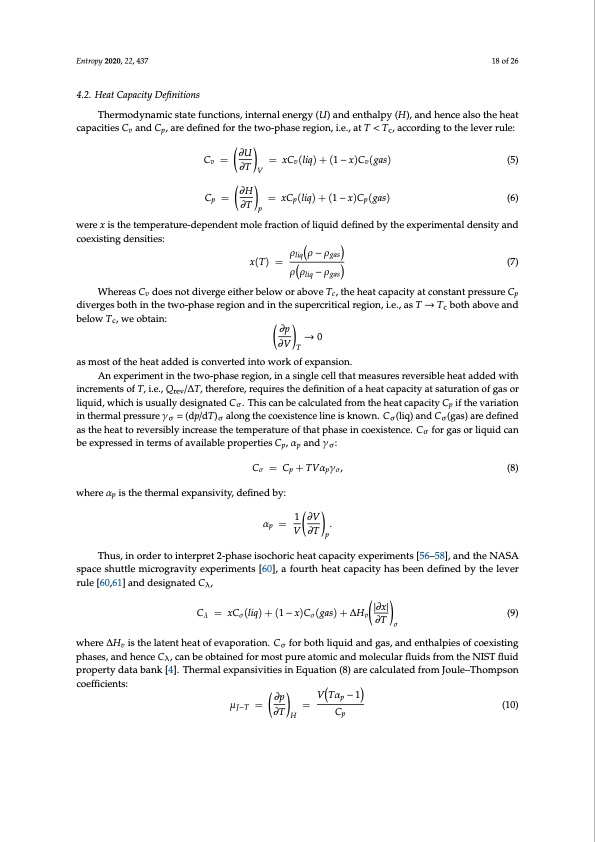
PDF Publication Title:
Text from PDF Page: 018
Entropy 2020, 22, 437 18 of 26 4.2. Heat Capacity Definitions Thermodynamic state functions, internal energy (U) and enthalpy (H), and hence also the heat capacities Cv and Cp, are defined for the two-phase region, i.e., at T < Tc, according to the lever rule: ∂U Cv = ∂T V ∂H = xCv(liq) + (1 − x)Cv(gas) (5) = xCp(liq) + (1 − x)Cp(gas) (6) Cp = ∂T were x is the temperature-dependent mole fraction of liquid defined by the experimental density and coexisting densities: p x(T)=ρρ −ρ (7) liq gas ρ ρ−ρ liq gas Whereas Cv does not diverge either below or above Tc, the heat capacity at constant pressure Cp diverges both in the two-phase region and in the supercritical region, i.e., as T → Tc both above and below Tc, we obtain: ∂p ∂V →0 T as most of the heat added is converted into work of expansion. An experiment in the two-phase region, in a single cell that measures reversible heat added with increments of T, i.e., Qrev/∆T, therefore, requires the definition of a heat capacity at saturation of gas or liquid, which is usually designated Cσ. This can be calculated from the heat capacity Cp if the variation in thermal pressure γσ = (dp/dT)σ along the coexistence line is known. Cσ(liq) and Cσ(gas) are defined as the heat to reversibly increase the temperature of that phase in coexistence. Cσ for gas or liquid can be expressed in terms of available properties Cp, αp and γσ: Cσ =Cp+TVαpγσ, (8) where αp is the thermal expansivity, defined by: 1 ∂V αp = V ∂T . p Thus, in order to interpret 2-phase isochoric heat capacity experiments [56–58], and the NASA space shuttle microgravity experiments [60], a fourth heat capacity has been defined by the lever rule [60,61] and designated Cλ, |∂x| Cλ = xCσ(liq) + (1 − x)Cσ(gas) + ∆Hv ∂T (9) where ∆Hv is the latent heat of evaporation. Cσ for both liquid and gas, and enthalpies of coexisting phases, and hence Cλ, can be obtained for most pure atomic and molecular fluids from the NIST fluid property data bank [4]. Thermal expansivities in Equation (8) are calculated from Joule–Thompson coefficients: ∂p VTαp −1 μJ−T = ∂T = C (10) Hp σPDF Image | Supercritical Fluid Gaseous and Liquid States

PDF Search Title:
Supercritical Fluid Gaseous and Liquid StatesOriginal File Name Searched:
entropy-22-00437.pdfDIY PDF Search: Google It | Yahoo | Bing
Sulfur Deposition on Carbon Nanofibers using Supercritical CO2 Sulfur Deposition on Carbon Nanofibers using Supercritical CO2. Gamma sulfur also known as mother of pearl sulfur and nacreous sulfur... More Info
CO2 Organic Rankine Cycle Experimenter Platform The supercritical CO2 phase change system is both a heat pump and organic rankine cycle which can be used for those purposes and as a supercritical extractor for advanced subcritical and supercritical extraction technology. Uses include producing nanoparticles, precious metal CO2 extraction, lithium battery recycling, and other applications... More Info
| CONTACT TEL: 608-238-6001 Email: greg@infinityturbine.com | RSS | AMP |